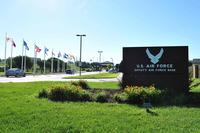
Science advisors to the Marine Corps brigade deployed to western Iraq are eyeing a concept for a new flying drone armed with lethal and non-lethal weapons to help disrupt insurgent cells with sudden airborne attacks.
Such a drone would take the fight to anti-Iraqi forces in areas where they currently perceive sanctuary, according to a briefing provided by one advisor, who requested anonymity because he is not authorized to speak to the press.
The concept is to take an existing Tier II medium-size drone in the vein of the 10-foot-wingspan Boeing/InSitu Scan Eagle, and fit it with two 40-millimeter grenade launchers, two green-laser dazzlers and a focused sound device similar to the Long-Range Acoustic Device manufactured by American Technology Corporation. This suite would give Marine operators escalation of force options, according to the briefing.
In other words, the drone would be able to first warn off suspected insurgents by beaming a verbal message in Arabic. If the suspects dont disperse, the drone can dial up the intensity of its sound broadcast, causing pain and disorientation. If that doesnt work, there are the laser dazzlers, which can cause temporary blindness from up to a mile away. If, after all of this, the suspects are still behaving threateningly, the drone can fire its grenade launchers.
Marine Corps officials in western Iraq signed separate official needs statements requesting the drone in September and November. The request is pending at Marine Corps Combat Development Command in Quantico, Virginia. But the Quantico weapons-buying bureaucracy has previously rejected scores of similar needs statements asking for a wide range of ground and air weapons.
Indeed, Quantico has earlier rejected separate requests for three of the major components of the proposed new drone. Marines in Iraq asked for additional acoustic devices for ground use and were denied. In 2005 and 2006 they repeatedly requested laser dazzlers, also for ground use, and Quantico said no, citing safety concerns.
Multiple needs statements calling for hundreds of unarmed Tier II drones for surveillance missions were all ignored or turned down in favor of a planned competition for a new drone design beginning next year. The science advisors armed drone, representing a combination of three technologies that Quantico has repeatedly denied, stands little chance of finding favor with the bureaucracy.
Marine Lieutenant Colonel P.J. Kerr, a drone expert at the Pentagon, says that unlike the Army, Navy and Air Force, the service has no plans yet to arm any of its drones. Thats something were looking at very hard. Its being studied.
Ironically, Marine Corps units in western Iraq do benefit from the presence of armed Army Warrior drones operating on an experimental basis as part of the secretive Task Force Odin, which uses drones, sensors and manned aircraft connected by a wireless network to quickly find, identify and kill insurgent bomb teams.
The proposed Marine Corps armed drone would end the need for Task Force Odins services, the anonymous advisor contends.
-- David Axe









